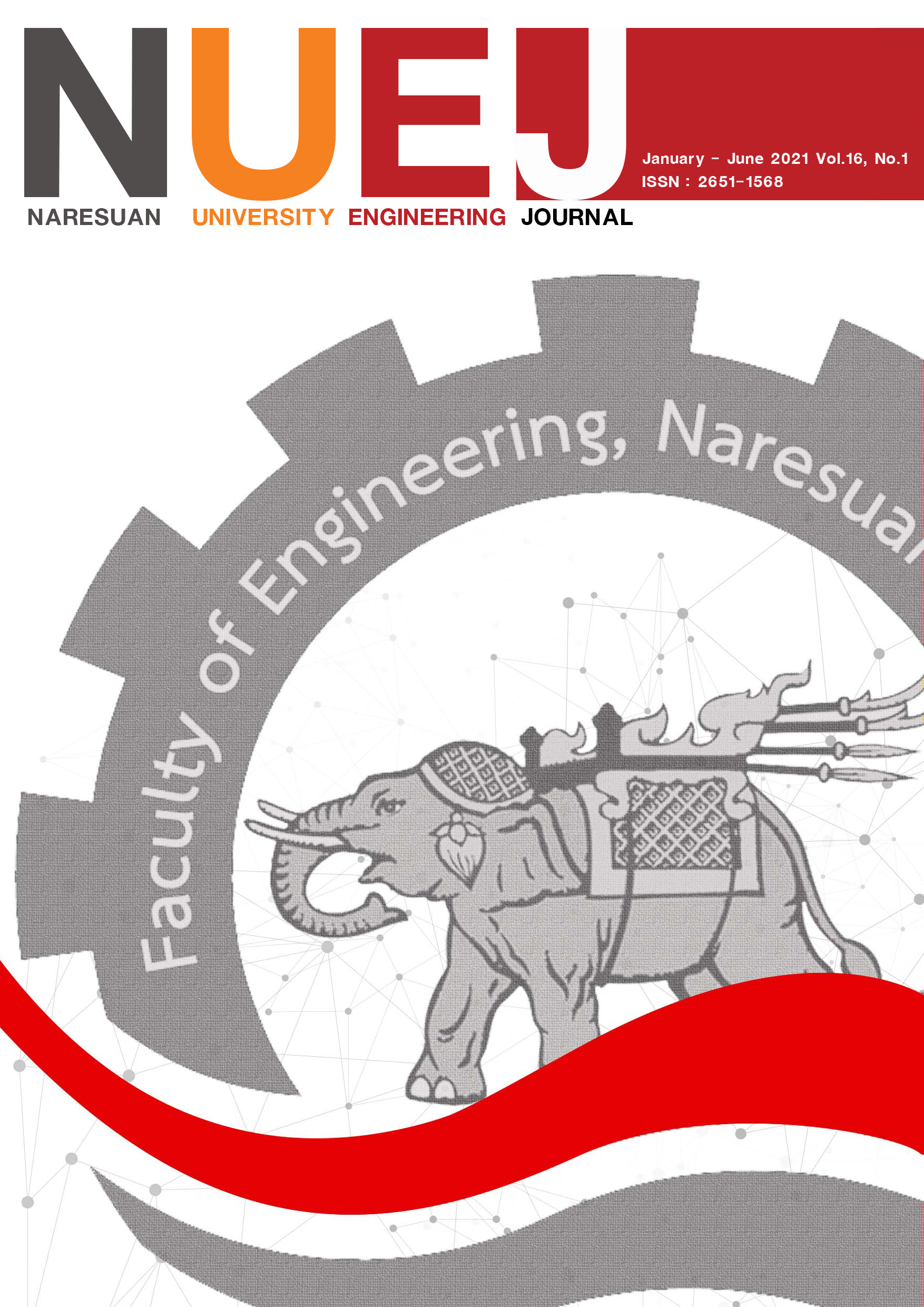แบบจำลองค่าที่ดีที่สุดสำหรับวางแผนนิคมอุตสาหกรรมโดยพิจารณาปัจจัยทางด้านความปลอดภัย
Main Article Content
บทคัดย่อ
ปัจจุบันหลาย ๆ ประเทศได้มีการจัดตั้งนิคมอุตสาหกรรมโดยมีวัตถุประสงค์เพื่อใช้สำหรับเป็นพื้นที่ในการประกอบกิจการของโรงงานอุตสาหกรรมและยังเป็นการส่งเสริมภาคอุตสาหกรรมให้เจริญเติบโตรวมถึงการเพิ่มจำนวนของนิคมอุตสาหกรรมเพื่อเป็นการรองรับการขยายตัวทางภาคเศรษฐกิจและภาคอุตสาหกรรม ทั้งนี้งานวิจัยทางด้านการวางแผนที่ตั้งโรงงานในนิคมอุตสาหกรรมในปัจจุบันยังมีจำกัด นอกจากนี้งานวิจัยที่มีอยู่เป็นการพิจารณาปัจจัยด้านต้นทุนเพียงอย่างเดียว โดยงานวิจัยนี้เป็นการศึกษาปัจจัยด้านความปลอดภัยที่ส่งผลต่อการออกแบบที่ตั้งของโรงงานอุตสาหกรรมในนิคมอุตสาหกรรม โดยพัฒนาแบบจำลองทางคณิตศาสตร์แบบโปรแกรมเชิงเส้นผสมจำนวนเต็มโดยในกรณีศึกษาจะแบ่งประเภทของโรงงานอุตสาหกรรมในนิคมอุตสาหกรรมออกเป็น 2 ประเภท คือ ประเภทโรงงานที่มีลักษณะอันตรายและโรงงานอุตสาหกรรมทั่วไป นอกจากนี้ยังได้จำลองผลกระทบของความรุนแรงจากกรณีเกิดเหตุฉุกเฉินของโรงงานอุตสาหกรรมโดยใช้โปรแกรม Areal Locations of Hazardous Atmospheres (ALOHA) เพื่อใช้เป็นข้อมูลป้อนให้กับแบบจำลองทางคณิตศาสตร์ โดยผลการจำลองพบว่าตำแหน่งของโรงงานอุตสาหกรรมส่วนใหญ่ถูกกำหนดให้อยู่บริเวณพื้นที่ลึกเข้าไปด้านในนิคมอุตสาหกรรมและกระจายอยู่รอบ ๆ นิคมอุตสาหกรรมเพื่อหลีกเลี่ยงพื้นที่เสี่ยงที่ได้รับผลกระทบเมื่อเกิดเหตุฉุกเฉิน โดยมีบางส่วนที่ถูกเลือกให้ตั้งในพื้นที่ที่มีความเสี่ยงซึ่งเป็นพื้นที่ขนาดเล็กและได้รับผลกระทบน้อย ซึ่งผลจากการบูรณาการการศึกษาระหว่างโมเดลทางคณิตศาสตร์และแบบจำลองทางคอมพิวเตอร์ในงานวิจัยนี้สามารถนำไปเป็นเครื่องมือเพื่อช่วยในการตัดสินใจออกแบบที่ตั้งโรงงานอุตสาหกรรมหรือออกแบบสถานที่ที่ต้องการศึกษาต่าง ๆ ได้ต่อไป
Article Details
เอกสารอ้างอิง
Alves, D. T. S., de Medeiros, J. L., & Ofelia de Queiroz, F. A. (2016). Optimal determination of chemical plant layout via minimization of risk 20.to general public using Monte Carlo and Simulated Annealing techniques. Journal of Loss Prevention in the Process Industries, 41, 202-214.
BOI. (2019, Apr 24). Thailand Board of Investment. https://www.boi.go.th/
Caputo, A. C., Pelagagge, P. M., Palumbo, M., & Salini, P. (2015). Safety-based process plant layout using genetic algorithm. Journal of Loss Prevention in the Process Industries, 34, 139-150.
Chae, J., & Regan, A. C. (2016). Layout design problems with heterogeneous area constraints. Computers & Industrial Engineering, 102, 198-207.
Chaiyaphan, C., & Ransikarbum, K. (2020). Criteria analysis of food safety using the Analytic Hierarchy Process (AHP)-a case study of Thailand’s fresh markets. In E3S Web of Conferences (Vol. 141, p. 02001). EDP Sciences.
Chanthakhot, W., Wattanaseang, N., Wisesla, K., & Ransikarbum, K. (2018, July). Computer Simulation-based Impact Assessment of LPG Storage Tank’s Leakage and Explosion in Split-type Air Conditioner Factory [Paper presentation]. In 2018 IE Network Conference, Bangkok, Thailand.
Chanthakhot, W., & Ransikabum, K. (2019, December). Numerical Simulation for Fire Emergency Planning in a Home Appliances Factory [Paper presentation]. In 2019 Research, Invention, and Innovation Congress (RI2C) IEEE. Bangkok, Thailand.
IEAT. (2020, March 2). Annual Report 2018. https://www.ieat.go.th/annual-report
Jung, S., Ng, D., Laird, C. D., & Mannan, M. S. (2010). A new approach for facility siting using mapping risks on a plant grid area and optimization. Journal of Loss Prevention in the Process Industries, 23(6), 824-830.
Kim, J., Ransikarbum, K., Kim, N., & Paik, E. (2016, May). Agent-based simulation modeling of low fertility trap hypothesis. In Proceedings of the 2016 ACM SIGSIM Conference on Principles of Advanced Discrete Simulation (pp. 83-86).
Medina-Herrera, N., Jiménez-Gutiérrez, A., & Grossmann, I. E. (2014). A mathematical programming model for optimal layout considering quantitative risk analysis. Computers & Chemical Engineering, 68, 165-181.
Oh, Y., Ransikarbum, K., Busogi, M., Kwon, D., & Kim, N. (2019). Adaptive SVM-based real-time quality assessment for primer-sealer dispensing process of sunroof assembly line. Reliability Engineering & System Safety, 184, 202-212.
Patsiatzis, D. I., Knight, G., & Papageorgiou, L. G. (2004). An MILP approach to safe process plant layout. Chemical Engineering Research and Design, 82(5), 579-586.
Puchongkawarin, C., & Ransikarbum, K. (2020). An Integrative Decision Support System for Improving Tourism Logistics and Public Transportation in Thailand. Tourism Planning & Development, 1-16.
Rahman, S. M. T., Salim, M. T., & Syeda, S. R. (2014). Facility layout optimization of an ammonia plant based on risk and economic analysis. Procedia Engineering, 90, 760-765.
Ransikarbum, K. (2020). Analysis of Traffic Flow at a Red Light Intersection using Computer Simulation technique. Thai Journal of Operations Research: TJOR, 8(2), 1-14.
Ransikarbum, K., & Mason, S. J. (2016). Multiple-objective analysis of integrated relief supply and network restoration in humanitarian logistics operations. International Journal of Production Research, 54(1), 49-68.
Ransikarbum, K., & Mason, S. J. (2016). Goal programming-based post-disaster decision making for integrated relief distribution and early-stage network restoration. International Journal of Production Economics, 182, 324-341.
Ransikarbum, K., Kim, N., Ha, S., Wysk, R. A., & Rothrock, L. (2017). A highway-driving system design viewpoint using an agent-based modeling of an affordance-based finite state automata. IEEE Access, 6, 2193-2205.
Ransikarbum, K., Ha, S., Ma, J., & Kim, N. (2017). Multi-objective optimization analysis for part-to-Printer assignment in a network of 3D fused deposition modeling. Journal of Manufacturing Systems, 43, 35-46.
Ransikarbum, K., Pitakaso, R., & Kim, N. (2020). A Decision-Support Model for Additive Manufacturing Scheduling Using an Integrative Analytic Hierarchy Process and Multi-Objective Optimization. Applied Sciences, 10(15), 5159.
Thai Appraisal. (2018, March 3). The 2018 costs of constructions.http://www.thaiappraisal.org/thai/value/value.php
BSA. (2019, March 1). Building inspection law. http://www.bsa.or.th/
UNCTAD. (2020, February 24). World investment reports 2019: Special Economic Zones. https://unctad.org/
Wang, R., Wu, Y., Wang, Y., & Feng, X. (2017). An industrial area layout design methodology considering piping and safety using genetic algorithm. Journal of cleaner production, 167, 23-31.
Wattanasaeng, N., & Ransikarbum, K. (2019, December). Cost Optimization Model for Plant Assignment in Industrial Estate Planning. In 2019 Research, Invention, and Innovation Congress (RI2C) IEEE, Bangkok, Thailand.
Wattanasaeng, N. & Ransikarbum, K. (2020). Sites Selection of industrial estates for Thailand Border’s Special Economic Zones using Data Envelopment Analysis. UBU Engineering Journal, 13(2), 14-26.
Wattanasaeng, N., & Ransikarbum, K. (2021). Model and Analysis of Economic-and Risk-Based Objective Optimization Problem for Plant Location within Industrial Estates Using Epsilon-Constraint Algorithms. Computation, 9(4), 46.
Wu, Y., Wang, Y., & Feng, X. (2016). A heuristic approach for petrochemical plant layout considering steam pipeline length. Chinese journal of chemical engineering, 24(8), 1032-1037
Yuan, X. U., Zhenyu, W. A. N. G., & Qunxiong, Z. H. U. (2013). An improved hybrid genetic algorithm for chemical plant layout optimization with novel non-overlapping and toxic gas dispersion constraints. Chinese Journal of Chemical Engineering, 21(4), 412-419.


